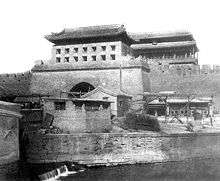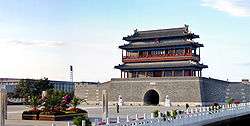Yongdingmen
Yongdingmen (simplified Chinese: 永定门; traditional Chinese: 永定門; pinyin: Yǒngdìngmén) was the former front gate of the outer city of Beijing's old city wall. Originally built in 1553 during Ming Dynasty, it was torn down in the 1950s to make way for the new road system in Beijing. In 2005, the Yongdingmen was reconstructed at the site of the old city gate. This new gate is disconnected from the original road leading towards the gate and into the city (see photograph below).


During the Boxer rebellion, on 11 June 1900, the secretary of the Japanese legation, Sugiyama Akira (杉山 彬), was attacked and killed by the Muslim soldiers of General Dong Fuxiang near Yongdingmen, who were guarding the southern part of the Beijing walled city.[1]
China and the Boxers: A short history of the Boxer outbreak, with two chapters on the sufferings of missionaries and a closing one on the outlook, Zephaniah Charles Beals, pp. 73-5.[2]
The Boxer Rising: A History of the Boxer Trouble in China, pp. 59-60.[3] The Boxer Rising: A History of the Boxer Trouble in China. Reprinted from the "Shanghai Mercury.", pp. 46-7.[4]
References
- Larry Clinton Thompson (2009). William Scott Ament and the Boxer Rebellion: heroism, hubris and the "ideal missionary". McFarland. p. 52. ISBN 0-7864-4008-2.
- Beals, Zephaniah Charles (1901). China and the Boxers: A short history of the Boxer outbreak, with two chapters on the sufferings of missionaries and a closing one on the outlook. M.E. Munson. p. 73. Retrieved 24 April 2014.CS1 maint: ref=harv (link)
- The Boxer Rising: A History of the Boxer Trouble in China (2, reprint ed.). Shanghai Mercury. 1901. p. 59. Retrieved 24 April 2014.CS1 maint: ref=harv (link)
- The Boxer Rising: A History of the Boxer Trouble in China. Reprinted from the "Shanghai Mercury." (reprint ed.). Shanghai mercury, limited. 1900. p. 46. Retrieved 24 April 2014.CS1 maint: ref=harv (link)